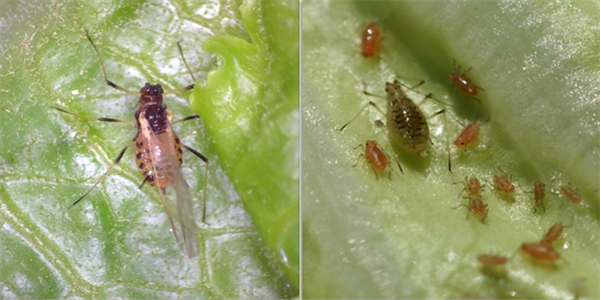This is turning out to be one heavy aphid season, particularly with the areawide green peach aphid pressure we’ve experienced so far. The good news is, as temperatures begin to increase, we should see green peach aphids decline. However, Lettuce aphids, Nasonovia ribisnigri, (aka., red aphid) have begun to show up in lettuce in several locations throughout the desert. I’ve had several calls from PCAs reporting light colonies in the North Gila and Yuma Valleys, Tacna, and Wellton, and we’re beginning to pick them up on our romaine at the Ag Center. I would consider this normal, compared to last season where lettuce aphid was present all winter/spring. Of course, we had a much milder winter last year. These recent findings are typical for the desert, where we generally associate lettuce aphid with the warmer growing conditions in late-February and March. Experience has taught us that daytime high temperatures in the 70s are ideal for lettuce aphid population growth compared to green peach aphid, which prefers highs in the 50-60’s. Our local weather forecast suggests that high temperatures will be in the high 70s to low 80’s with moderate nighttime lows in the 50-60’s for the next two weeks. These conditions will be conducive for lettuce and foxglove aphid population growth, so be prepared to battle them.
A few things to remember about lettuce aphids relative to the other aphids we commonly see. First, the immature nymphs are small and have a red appearance, whereas the apterous (wing-less) adults are typically a large brown colored aphid with dark bands running across the abdomen (see images below). Second, among the crops we grow locally, lettuce aphids are only found on the lettuce types (Lactuca spp.). Lettuce aphids prefer to colonize the terminal growth, and can often be found in heads or hearts, whereas green peach aphids are often found on the frame leaves in high numbers before moving into the heads. Sampling should be focused on the terminal growth of young plants, and in the heads and hearts of older plants. Third, they can reproduce prolifically, producing many more alates (winged) adults than other species, which can quickly lead to widespread abundance in a field and dispersal throughout a growing area. Finally, as the saying goes "he who hesitates is lost". If lettuce aphids are found on your lettuce, it is recommended that you respond quickly with an insecticide treatment. The product of choice is Movento at 5 oz/ac. Because of its systemic activity, Movento will reach aphids in the protected terminal growth. Be sure to include a penetrating adjuvant for best results at a rate of at least 0.25% v/v. It normally requires about 7 days of activity before significant reduction in the infestation is observed but can take longer (10-14 days) in cool, cloudy weather. Sequoia, Sivanto, Beleaf, PQZ and Versys are good rotational products if spray coverage to terminal growth can be reached. For more information on lettuce aphid please refer to Lettuce Aphid on Spring Produce-2023. If you’re finding lettuce aphid on organic lettuce, good luck; we’ve not had much success in controlling them with organically-approved biopesticides (azadirachtin, pyrethrins, soaps, oils, entomopathogens, etc.).






